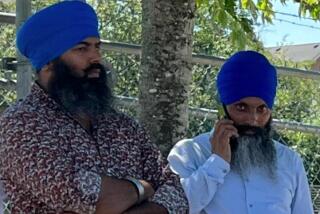Sikhs use Rose Parade float in effort to build understanding
When Minu Kaur Singh walks down the street with her husband and children, she hears the comments as people pass by.
Her husband is a doctor but what people notice first is the long beard and turban he wears, following the tenets of their Sikh religion.
“It’s not that people do it intentionally,” she said. “It’s fear of the unknown.”
Several Sikh groups are hoping to fight that fear Jan. 1, when their float rolls through the streets of Pasadena as part of the Rose Parade. The float is directed less at the more than the 700,000 people lining the streets on New Year’s Day than the 55 million or so people who will watch it on television in the U.S.
In the days leading up to the parade, the float was in a Pasadena warehouse, where it was being completed by Phoenix Decorating Co., which has built 18 of the 40 floats in the parade. The float cost about $300,000, which was raised from Sikhs around the country.
The float, with 17,000 multicolored roses and 2,500 gerbera daisies, tells the story of the Sikhs’ 125 years in this country. At the top is a replica of the first gurdwara, or temple, constructed in the U.S. It was built in Stockton in 1912 by immigrants from Indian state of Punjab, where most Sikhs are from.
A railroad engine represents the Sikhs who came to this country to work on the railroads. The red tractor and the peaches, grapes, almonds, cantaloupes and green fields highlight the number of Sikhs in agriculture. On the side of the float are photographs of prominent Sikhs, including one of a man dressed as Captain America.
Standing on a platform at the front of the 55-foot-long float will be a Sikh serviceman and three police officers, jobs Sikhs still are fighting for because of their turbans and beards. Sitting on a park bench will be doctors, lawyers and Boy Scouts, showing that a turbaned Sikh can be the person next door. At the front, the float says, “Sikh American Journey” in red, white and blue.
The Sikhs are not the first religious group to have a float in the parade. The Lutheran Laymen’s League, with a float depicting Noah’s Ark , is participating for the 65th time this year.
“It’s not what we believe in,” said a yellow-turbaned Rashpal Dhindsa, who came up with the idea of putting a float in the Rose Parade. His group provides eye care to the poor in rural India. “It’s about who we are.”
The float is the latest tactic Sikh groups have used to show they are part of the American mainstream. Over the summer, Comcast donated $2.5 million worth of air time so the Sikh American Legal Defense and Education Fund could show a 30-second public service announcement on its networks, including CNBC, A&E and TNT, showing Sikhs playing basketball, flying an airplane and riding a Harley. It showed a Sikh, nicknamed “The Turbanator,” competing on “American Idol.”
Another group has started the four-day Sikhlens Art and Film Festival with Chapman University’s Dodge College of Film and Media Arts in Orange, giving scholarships so students can make movies about Sikhs. Sikhlens has grown to include festivals in New York, San Jose, Toronto and Yuba City, home to a large number of Sikhs.
With 29.5 million members, most of them in India, Sikhs make up the fifth-largest religion in the world, “probably one of the least understood,” said Bhajneet Singh of the Khalsa Care Foundation, one of the groups sponsoring the float. About 700,000 live in the U.S., with the largest concentrations in New York and California.
Sikhs had been on the receiving end of racist comments before, but things got worse after the attack on the World Trade Center when some were victims of misplaced anti-Muslim taunts.
“We really stand out in a crowd,” said Jasit Singh, executive director of the Sikh American Legal Defense and Education Fund, who recently returned from a United Nations conference in Berlin on anti-Semitism. “In the post-9/11 environment, it really has been a target on our back in many ways.”
Things have calmed down since then, said Bhajneet Singh, with many people making anti-Sikh comments hiding behind the anonymity of the Internet.
Still, a study the group commissioned by Stanford University’s Peace and Innovation Lab found a lack of knowledge about Sikhs, with almost half the respondents thinking it was a Muslim sect, and that there was bias against those wearing turbans.
The worst ant-Sikh moment came in 2012 when a white supremacist killed six people at a gurdwara in Wisconsin before committing suicide.
“That was really a wake-up call for us that even though we had been doing this work raising awareness, we needed go faster, needed do more,” Singh said.
Twitter: @gottliebjeff
More to Read
Sign up for Essential California
The most important California stories and recommendations in your inbox every morning.
You may occasionally receive promotional content from the Los Angeles Times.











